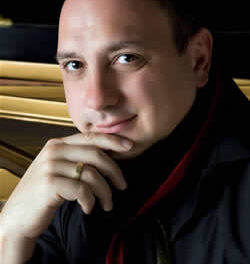One of the great classical record covers of all time, now almost 50 years old, is Columbia MS 6349. In the center, filling up almost the entire 12 ½ x 12 ½-inch surface, is a blazingly bright bronze part of a chamberlain’s key from the period of Czar Alexander II, standing out in stark contrast against a plain black background. Above the winged two-headed beast, crown and cross are the elegant letters: “World Premiere Recording,” “The Philadelphia Orchestra, Eugene Ormandy, Conductor,” “Tchaikovsky-Symphony No. 7 in E-Flat Major.” To a teenager who was beginning to learn a bit about classical music and was familiar with Tchaikovsky’s 4th, 5th and 6th symphonies, this recording was magical, almost like the discovery of buried treasure, as well as a surprise. A 7th Symphony? Really?
Yes, really, and the North Carolina Symphony, under the energetic direction of resident conductor William Henry Curry, brought this musical rarity to vivid life in its Duke Medicine subscription concert series at Meymandi Concert Hall.
The 7th symphony is now identified more accurately as Tchaikovsky’s work, “edited by” Semyon Bogatiryov in the 1950s, and it might even contain some scoring by Sergei Taneyev from the late 1890s, too. Nevertheless, the symphony is full-blooded Russian romanticism from the waning days of the 19th century, and it was played with great gusto by the orchestra, although before a surprisingly less-than-full auditorium.
Those familiar with the broad range of Tchaikovsky’s compositions already might know this symphony in its other incarnations: the beginning of his rarely-played Piano Concerto No. 3, part of his Andante for Piano and Orchestra and a portion of a set of piano pieces from Op. 72. In that regard, the symphony might be considered at best a kind of grab-bag of musical ideas, but when all put together it comes together quite nicely.
The opening allegro brilliante movement has passages that sound like not-so-distant relatives of parts of the composer’s Symphony No. 1, and part of the theme in the second (andante) movement is as emotionally charged as the soaring theme in the Romeo and Juliet Fantasy-Overture that opened the Raleigh concert. The whirling figures from strings and winds (and harp) in the third (vivace assai) movement could easily have come from a section of ballet (the Nutcracker, perhaps?). The heroic allegro maestoso finale opens with a furious six-note statement and includes a grand march, complete with snare drum and Sousa-like flute passages, that almost rivals the ending to the Fifth Symphony.
As with many of Tchaikovsky’s compositions, strong brass and wind sections are required, and on this count, the NC Symphony players acquitted themselves with distinction. Whether in exposed lines and passages or as foundations for other sections, the trumpets, trombones, French horns, and tuba excelled, coming close to raising the rafters at the end of the fourth movement; and the flutes, piccolo, oboes, clarinets, and bassoons offered a fine blend of contrasting voices in their passages. All string sections projected clarity and precision, and they were soft and lush or strong and bold as the score required. Curry, a Tchaikovsky fan, has called the work the greatest symphony that nobody knows, and the folks at Sony-Columbia have not seen fit to re-release Ormandy’s wonderful 1962 recording on compact disc. More’s the pity. Curry and the NCS deserve praise for both rescuing the work from obscurity and giving it such a spirited reading.
Two other pieces offered more of Tchaikovsky’s beautiful melody and more of the orchestra’s sparkling playing. Principal cellist Bonnie Thron infused the “Variations on a Rococo Theme,” Op. 33, with a huge dose of energy and spirited playing, as well as moments of quiet introspection, and she received fine support from the orchestra throughout. The main theme is deceptively simple, in contrast with variations that are at times fiendishly complex, requiring the nimblest of fingering, some double-stopping, and finding the right pitch at the absolute highest register of the instrument. Ms. Thron’s playing of the more lyrical passages that strayed farthest from the core of the main theme was especially fine, although at times her light touch caused some notes to disappear behind the orchestra. For the most part, however, her cello stayed at the forefront. There were several nice duets between the cello and other instruments, too, and she certainly nailed the devilishly fast seventh variation to bring the piece to an end.
Even though the subject matter of the Romeo and Juliet Fantasy-Overture has a highly charged emotional character, Tchaikovsky at age 29 poured his own sense of emotion into the work, creating a gorgeous melody for a dramatic musical retelling of the doomed lovers’ story. The tension that builds in the winds and basses at the opening gradually unfolds into a full-blown theme of great beauty, one of the composer’s best, and the orchestra gave perhaps its finest playing of the night on this piece. Curry directed some of the string passages in a slightly slower tempo than one might be used to, and the players responded with a truly wonderful sound that never dragged. The brasses and winds provided nice contrast to the strings — the trumpets were especially crisp in advance of forte passages, and the French horns and winds were wonderful in the hymn-like passage leading to the stirring conclusion.
*For a letter to the editor concerning this review, click here.













